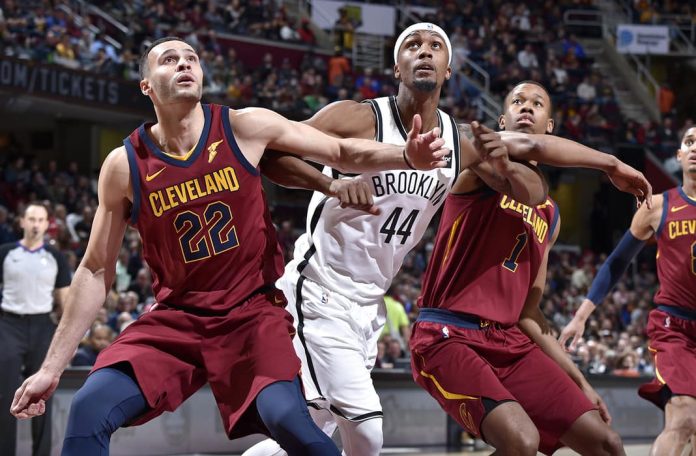From a young age, one of the core fundamentals of basketball that’s taught is rebounding. Coaches would spend whole practices devoted to teaching how to box out and how to establish position on the block. It’s important to learn how to do it because as one gets older, the opposing teams are only going to get bigger. While that’s certainly true in today’s NBA, does that mean that rebounding is still an emphasis?
In an article for Men’s Journal that was released prior to the start of the 2017-18 season, it was discovered that the average height of an NBA player is 6’7.23″. It would make sense that the best teams the league has to offer would also be at or near the top of the leaderboard in rebounding… right?
Here are the official standings at the end of the 2017-18 NBA regular season, followed by the number of rebounds they averaged per game and their league ranking; starting with the Western Conference:
-
Houston Rockets: 43.5, 18th
-
Golden State Warriors: 43.5, 17th
-
Portland Trail Blazers: 45.5, 4th
-
Oklahoma City Thunder: 45.1, 5th
-
Utah Jazz: 43.3, 20th
-
New Orleans Pelicans: 44.3, 10th
-
San Antonio Spurs: 44.2, 11th
-
Minnesota Timberwolves: 42.0, 24th
And the Eastern Conference:
-
Toronto Raptors: 44.0, 13th
-
Boston Celtics: 44.5, 8th
-
Philadelphia 76ers: 47.4, 1st
-
Cleveland Cavaliers: 42.1, 23rd
-
Indiana Pacers: 42.3, 22nd
-
Miami Heat: 43.5, 19th
-
Milwaukee Bucks: 39.8, 30th
-
Washington Wizards: 43.1, 21st
As always, context is important.
For instance, the Utah Jazz were without Rudy Gobert and his career 10.0 rebounds per game average for 26 games. Two of the other teams in the top-five in team rebounding were the Los Angeles Lakers (second) and the Charlotte Hornets (third). The Brooklyn Nets were a better rebounding team (statistically speaking) than the top-seed in the Eastern Conference. Obviously, there’s more to basketball than just rebounding, but does that mean it’s not important?
Teams like the Houston Rockets and the Golden State Warriors can get away with being in the middle of the pack because their starting lineups feature multiple All-Stars and they’re pretty good at 3-point shooting. Or are they?
The Golden State Warriors ranked first in 3-point percentage (39.1% as a team) league-wide, but the Houston Rockets only ranked 14th (36.2%), tied with the New Orleans Pelicans. The Rockets also took the most 3-pointers per game, on average, by a large margin: 42.3 a game, 6.6 more than the next closest team, the Brooklyn Nets.
Maybe this can be accounted for because they’re good at offensive rebounding? Here are the top-five offensive rebounding teams:
-
Oklahoma City Thunder (12.5)
-
Denver Nuggets (11.0)
-
Philadelphia 76ers (10.9)
-
Los Angeles Lakers (10.7)
-
New York Knicks (10.5)
The Houston Rockets ranked 23rd last season, while the Golden State Warriors ranked 28th.
Then what is it then? How do teams like the Houston Rockets and Golden State Warriors continue to have such great success? The simple answer: transition.
The Golden State Warriors ranked second in points scored in transition (1,911), just eight points shy of the league-leading Los Angeles Lakers. It also helps they averaged 8.7 steals per contest, which put them in a three-way tie with the Atlanta Hawks and Phoenix Suns. Wait, what?
The Houston Rockets ranked 10th in total points in transition, compiling 1,588 over the course of the regular season but only averaged 7.4 steals per game, which was “good” for 20th in the league. Huh?
Well if it’s not just rebounding (offensive or defensive) and it’s not just 3-point shooting or transition stats, then what is it?
It’s not a perfect science, but the most telling statistic may be an under-appreciated one – blocks per game.
Of the top-15 teams in blocks per game, 11 were playoff teams (in descending order):
Golden State Warriors – 7.5, 1st
Toronto Raptors – 6.1, 2nd
New Orleans Pelicans – 5.9, 3rd
San Antonio Spurs – 5.6, 4th
Milwaukee Bucks – 5.4, 5th
Miami Heat – 5.3, 6th
Portland Trailblazers – 5.2, 7th
Utah Jazz* – 5.1, 9th
Philadelphia 76ers* – 5.1, 10th
Oklahoma City Thunder – 5.0, 11th
Houston Rockets – 4.8, 15th
*Denotes three-way tie between the New York Knicks, the Utah Jazz, and the Philadelphia 76ers
Of the other 15 teams, only four were playoff teams:
Boston Celtics – 4.5, 18th
Washington Wizards – 4.3, 22nd
Minnesota Timberwolves – 4.2, 23rd
Cleveland Cavaliers – 3.8, 28th
Rebounding is often thought of as a team getting the ball in one of their player’s hands, but arguably the most important aspect of rebounding is making the other team miss. Luckily for most of this year’s playoff teams, they did just that.
The league average for opponent field goal percentage was 46.0. Of the 16 playoff teams, nine held opponents below league average. Of the remaining seven playoff teams, only two were in the “top-three” of opponent field goal percentage (which translates to the highest opponent field goal percentages) – the Minnesota Timberwolves and the Cleveland Cavaliers; coincidentally two of the teams that were in the bottom-five in terms of defensive rating.
The question still remains.
Is rebounding still important in today’s NBA?
As mentioned earlier, context is important. The Golden State Warriors are going to continue to be good as long as they continue to trot out four All-Stars in their starting five. The Rockets have their “Big 3” of James Harden, Chris Paul and Clint Capela for the foreseeable future. The Celtics will have a healthy Kyrie Irving and Gordon Hayward next season, and the Raptors added Kawhi Leonard and Danny Green. None of these players are being mentioned because they’re necessarily great rebounders but because it goes to show you there’s more to rebounding than just one statistic. It’s a multitude of factors, but they all contribute to winning.

